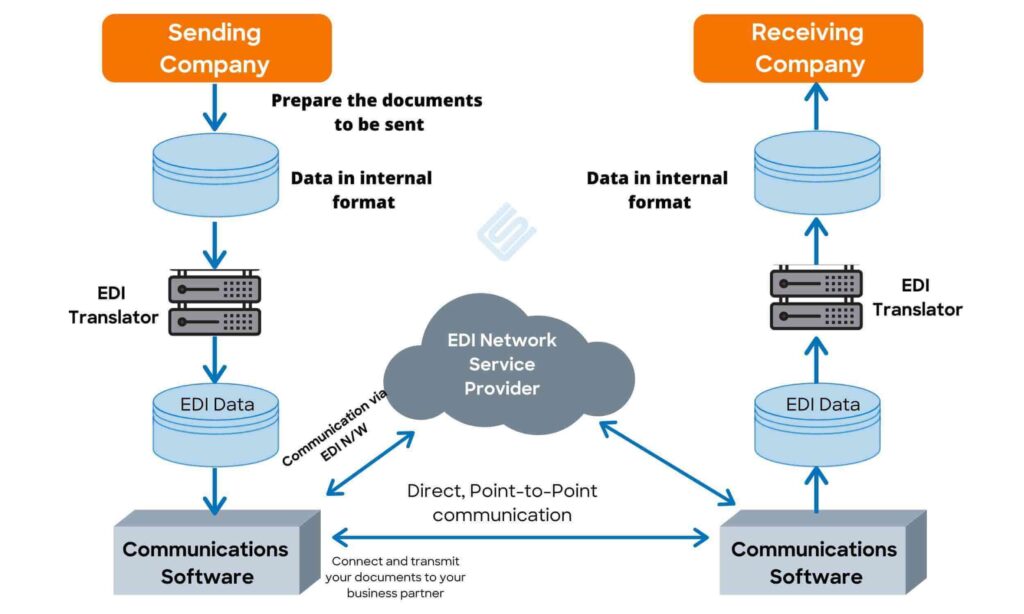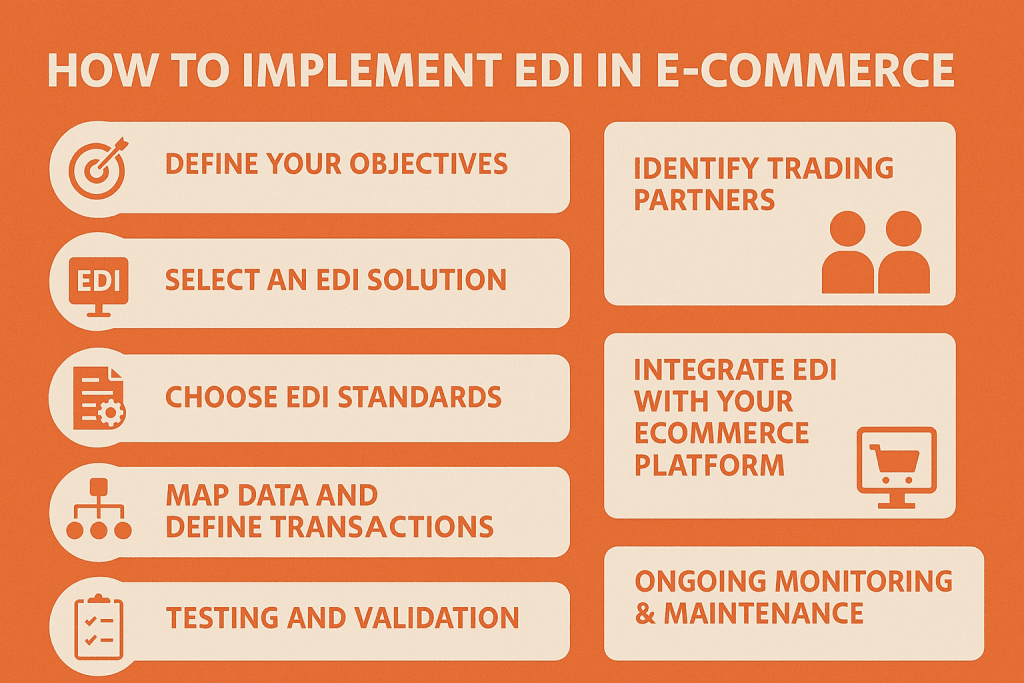E-commerce and EDI (Electronic Data Interchange) are modern phenomena in Advanced business techniques that allows companies to grow B2B as well as B2C models. The integration of EDI in eCommerce automates the data exchange process, reduces task time, risk, and cost of the business operations associated with document transmissions.
EDI in eCommerce enhances communication, improves accuracy, and facilitates standardized formats of documents. To take advantage of these modern terms, it is essential to know all the relevant details and apply them accordingly. In this direction, let’s dive into the related insights and know how to benefit from online selling by integrating Electronic Data Interchange.

Table of Contents
What is EDI in eCommerce?
EDI in eCommerce allows the business to electronically interchange its structured documents, such as invoices, purchase orders, and shipping notifications. It eliminates the manual data exchange and makes communication, transactions, and inventory management seamless. By becoming EDI capable, businesses can effortlessly integrate with trading partners, meet compliance requirements, and automate end-to-end workflows.
EDI in eCommerce: Key Figures and Facts
- An analysis based on 5 years of data shows that the global EDI market is worth USD 36 billion. Years of data show that the global EDI market is worth USD 36 billion. According to the World Bank, more than 75% of global trade transactions in 2024 follow EDI standards like EDIFACT and ANSI X12 and are adopted across industries.
- Electronic data interchange like real-time information sharing and optimized supply chain process, over 85% of eCommerce business has embraced B2B integration.
- Retailers adopting EDI reduce the invoice processing cost by approximately up to 70%-80% in comparision to manual processing.
- eCommerce giants like Amazon, Walmart, and Target instruct their suppliers to exchange business documents by using standardized electronic communication techniques.
- More than 85% of electronic business transactions rely on one or more type of EDI.
How Does Electronic Data Interchange (EDI) Work in eCommerce?
If you want to expand your online business into a B2B, wholesale, or retail market, increased order volume and complex transactions are inevitable. EDI support is a must-have for managing all the document exchange tasks efficiently. Following is the step-by-step process of EDI application in eCommerce:
Data Generation
When customers place orders through various channels, the system gathers all the necessary information from the order management system and enterprise resource planning (ERP) software.
The description of product, pricing, customer, and shipment are also included in the collected data. The formats of all the purchase orders, invoices, or shipment details must comply with the EDI’s standards so that interpretation can be accurate and consistent.
EDI Translation
After collecting figures and details, it is converted into a standardized format like ANSI, X12, or EDIFACT. This conversion involves data mapping from the internal business system and correlating with EDI fields. It validates the data by performing initial checks over the accuracy and inclusion of required details, along with verifying that all mandatory fields are filled. It is also ensured that the translated particulars are readable by the system of the opposite party.
Data Transmission
The system then passes prepared documents on a secure electronic channel to send to the relevant receiver. The intended recipient could include a business client, supplier, or logistics partner. You can do this transmission in several ways, such as establishing a direct connection between sender and receiver, using third-party connections called Value Added Networks (VANs), or using cloud-based platforms over the internet.
Order Processing
Upon receiving the transferred data, the recipient party inputs the details on their EDI software to ensure the correctness of the information. Once someone checks all the figures, the system puts documents on the trading partner’s ERP system for the next processing of orders, and the system updates inventories.
Shipment & Invoice
Once the order processing is completed, the system imports EDI Documents to the warehouse management system (WMS) to enable stock handling, picking, packing, and shipping of an order.
Later, the system gives customer-related particulars like order confirmation and transit notification to the customer relationship management system to provide timely updates.

Source:- sellerscommerce.com
Types of EDI Transactions Used in eCommerce
The most common transactions under use cases of EDI in eCommerce include:
EDI 810: Invoices
Suppliers use these documents to send invoices to customers. It generally includes details like the names of the buyer and seller, invoice number, date, and product information. These electronic papers simplify and speed up the billing and payment cycles.
EDI 820: Payment Order/Remittance Advice
The buyer uses this digital paper to send remittance advice and payment orders to the sellers/suppliers. These documents contain information about the said transactions, and the fund transfer is streamlined.
EDI 846: Inventory Inquiry
The real-time update of stock and the availability of products is informed by the transaction document. Thus, EDI for eCommerce helps the supplier in examining and improving stock management by providing real-time details about the inventory level in the warehouse.
EDI 850: Purchase Orders
Buyers send purchase orders to suppliers/dealers to initiate the order process. These orders contain information about both parties, the product, quantity, prices, and when the item will be delivered.
EDI 855: Order Acknowledgment
Once the supplier receives the purchase order, he confirms its receipt and informs the buyer about the acceptance, rejection, or required changes in the EDI 850 that the buyer sent.
EDI 856: Advance Shipping Notice (ASN)
This transaction paper is used to inform the buyer about the shipment details like transport of the goods with date when given to the carrier, its name, order tracking number, product specifics. This information allows the receiving party to track and prepare in advance for the coming deliveries.

Benefits of EDI in eCommerce
EDI applications in eCommerce bring numerous benefits listed below:
1. Increased Efficiency and Automation
Using EDI Solutions in digital business automates the process of exchanging documents like purchase orders, invoices, and shipping notices between trading partners. It replaces manual work and speeds up transactions while reducing the chances of errors. EDI in eCommerce not only shortens the delivery time but also streamlines the supply chain management, contributing to overall operational efficiency.
2. Reduced Errors and Improved Accuracy
Manual work is prone to mistakes, leading to delays and sometimes unavoidable blunders, costing both partners. But when human intervention is replaced by the automatic digital document exchange under the EDI applications in eCommerce. Thus an improved and error-free system accelerates quicker order fulfillment, timely delivery, and keeps reliable inventory levels.
3. Cost Savings
Elimination of human work reduces the need for an extensive labour force, huge piles of papers, and time-consuming processing. Thus, wages given for physical data entry, expenses on printing documents, cost associated with manual processes. At the same time, the amount spent on maintaining inventory is also reduced by removing overstocking and stockouts. All this contributes to significant money saving for the business using EDI for eCommerce.
4. Faster Order Processing and Fulfillment
Automatic transactions make the order processing a matter of minutes instead of days to finish. Real-time clarity of stock levels helps in maintaining product availability when required, making it easy to respond to customer demand. Thus, use cases of EDI in eCommerce have proven to contribute to the quick execution of the placed requests, leading to overall customer satisfaction.
5. Enhanced Supply Chain Visibility
With instant updates about the stock level, shipment tracking, and an eye on the movements of goods in-out of the warehouse, the trading company can have a clear view of its inventory management system. All the relevant parties, including the manufacturer, supplier, logistic provider, and distributor, can have seamless data exchange with EDI in eCommerce. This guides the business to make informed decisions for their supply chain operation and provides better control over it.
6. Improved Inventory Management
Electronic data interchange significantly improves inventory management by offering real-time stock transparency, refilling the warehouse shelves automatically, and even forecasting demands for certain products. It reduces the risks of shortage or excess of goods, ultimately minimizing the possibility of sale opportunity loss or heavy storage costs.
7. Stronger Trading Partner Relationships
Fast transaction processes and efficient communication enhance the collaboration between the trading parties, including manufacturer, supplier, and retailers. Elimination of manual follow-ups and automatic document exchange increase the partners’ satisfaction and loyalty towards each other, building a strong relationship among them.
8. Improved Customer Satisfaction
Customer experience is a crucial indicator of the success and growth of a business. EDI for eCommerce comes with numerous features like use cases of EDI in eCommercelive order tracking, instant notifications about status updates involving confirmations, shipping details, and delivery dates, enhancing the overall shopping experience of consumers. This satisfaction brings loyalty and positive reviews for the sellers and enables repetitive purchases.
9. Compliance and Standardization
By integrating EDI standards for eCommerce, you can leverage benefits like efficient handling of huge numbers of complicated transactions with multiple parties. It helps the business to grow and fulfill the increasing demands of customers. High volumes of data across various channels can be operated with minimum or no errors at all. Alongside this, the digital tool ensures that transmitted documents meet with the relevant industries’ rules and regulations so that any legal risk can be avoided.
How to Implement EDI in ECommerce?

A structured approach is necessary to incorporate a digital data exchange system in an online business. Here is an ideal process of implementing EDI in eCommerce:
1. Define Your Objectives
For implementing EDI in eCommerce, the first step is to clarify your business needs and objectives. Determine what you aim to attain with this digital tool. In this direction, a thorough assessment of ongoing processes can help identify the areas where integrating the digital transactions adds the highest value. The reasons for opting for automatic data exchange may include increasing cost or volume of transactions, limited capability of the current system, and supply chain complexity. The clarity of objectives establishes a base for selecting the right option among service providers.
2. Identify Trading Partners
Digital data exchange is carried out between trading partners, including suppliers, manufacturers, retailers, and /or logistic providers. Thus, before applying any business process automation, it is mandatory to recognize and collaborate with your trading alliance. It will shed a light on their EDI standards relevant for eCommerce, which is necessary for the smooth transmission of documents. Different parties may have distinct requirements of formats like ANSI, X12, or EDIFACT. Also, early discussion with them informs about their preference regarding connectivity.
3. Select an EDI Solution
Not all technological solutions can be equally beneficial for different types of industries with distinct business needs. Thus, while selecting a digital service, it is important to consider the elements that matter most for your company. You must pick a digital communication system that can integrate with the ongoing processes and is acceptable to the employees.
You can consider the selection among services like direct connection, cloud-based platforms, API integrations, or Value-Added Networks (VANs) based on the cost, ease of application, operational needs, alignment with business goals, and use cases of EDI in eCommerce.
4. Choose EDI Standards
This digital service works using some standardized formats like ANSI X12, EDIFACT, and XML. Each of these structures is popular across various industries and markets. Under these wide ranges of standards, distinct documents contain specific transactions for different purposes. An EDI provider can help you spot which sets are most useful for your business after assessing information exchange with trading partners and relevant regulatory compliances in the industry. Picking relevant standards for your business is mandatory to maintain accuracy and prevent obstacles in smooth processing.
5. Map Data and Define Transactions
Data is digitally exchanged between the trading alliances by converting it into a structured format. Thus, the transactions are defined by determining their respective types, such as 810 for invoices, 850 for purchase orders, and 846 for Inventory inquiries, etc.
Under mapping, internal business processes are matched with the predefined EDI formats and standards.
6. Integrate EDI in eCommerce Platform
When this digital and automated document exchange system is merged into your company’s existing eCommerce platform, ERP, and warehouse management software, it should be compatible with them.
Also, the operational workforce should accept and understand the selected EDI solutions. If the integration turns out evenly, you can achieve minimum error chances and faster transaction cycles.
7. Testing and Validation
The team conducts testing and validation before the final launch of the selected EDI solution. In this process, they send test documents to the relevant trading partners to mimic everyday transactions with them.
This helps in identifying any potential configuration problems and ensures that data flows correctly in the internal as well as external systems.
8. Ongoing Monitoring & Maintenance
The task of EDI implementation does not end here. Continuous monitoring is equally important for its flawless working.
Regular checking and refining of the system eliminates the risk of it getting outdated, which offers you the opportunity to keep your digital system scalable with the evolving needs of your business as well as trading partners.
Future Trends of EDI in eCommerce
It is expected that use cases of EDI in e-commerce will grow in the coming years. As technology is advancing, industries are likely to adopt comprehensive digital solutions in both their online and offline setups to streamline processes and handle complicated day-to-day operations with maximum speed and accuracy and at a lower cost. In the following key points, the future of this digital system can be estimated:
- The combination of EDI and APIs is evolving to generate live data exchange and enhanced flexibility.
- Blockchain is also increasingly used in the platform to improve transactional transparency and security.
- The integration of AI and Machine learning is being adopted in eCommerce with digital solutions for detecting errors in information flow.
- Smart devices and 5G technology could allow faster data transmission and more efficient time supply chain tracking.
- Cloud-based solutions are being widely used for cost-effective and scalable performance.
Streamline Your eCommerce Workflow with A3Logics’ Proven EDI Expertise
As we interpreted in the earlier section, the EDI implementation process can be complex, and it is very important to choose the right provider to leverage all the defined benefits. A3Logics carries an experience of 21+ years in providing efficient and streamlined EDI services.
Our team has completed 500+ projects with businesses coming from diverse industry bases and niches. Our years of experience help us to save development and implementation costs without compromising the overall project quality. At the same time, A3Logics provides a free consultation session that enables you to understand your real-time business challenges and curate a personalized digital product.
With a robust team of 350+ experts, A3Logics has managed to achieve a client retention rate of 91%, which portrays our commitment to quality and ultimate support. Our team is available around the clock to entertain feedback and provide technical assistance.
Conclusion
Electronic trading systems are reshaping the way eCommerce works by allowing businesses to self-operate their transactions with low error rates and improved efficiency. With features like faster order processing, enhanced stock management, companies are building strong trading partnerships. This digital platform is proven to be a game changer for the online industry. Companies embracing data automation are standing more competitive advantages with better customer satisfaction, which derive long-term success and growth. From small retailers to global ventures, every unit is adopting EDI in eCommerce. This is a clever investment for an absolute experience in online dealing.







